
The Belchertown State School for the Feeble-Minded was established in 1922 in Belchertown, Massachusetts. It became known for inhumane conditions and poor treatment of its patients, and became the target of a series of lawsuits prior to its eventual closing in 1992. The building complex was listed on the National Register of Historic Places in 1994.

Tewksbury Hospital is a National Register of Historic Places-listed site located on an 800+ acre campus in Tewksbury, Massachusetts. The centerpiece of the hospital campus is the 1894 Richard Morris Building.

Lakeville is a census-designated place (CDP) in Litchfield County, Connecticut, United States, close to Dutchess County, New York. It is within the town of Salisbury, but has its own ZIP Code (06039). As of the 2010 census, the population of Lakeville was 928, out of 3,741 in the entire town of Salisbury. The Hotchkiss School is located in Lakeville, and the Indian Mountain School is nearby.
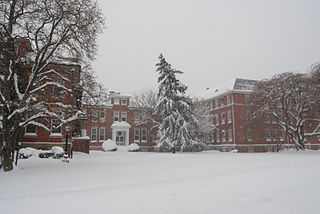
The Crownsville Hospital Center was a psychiatric hospital located in Crownsville, Maryland. It was in operation from 1911 until 2004.

The Philadelphia State Hospital at Byberry was a psychiatric hospital located on either side of Roosevelt Boulevard, US Route 1, in Northeast Philadelphia, Pennsylvania. It was located in the Somerton section of the city on the border with Bucks County. The name of the institution was changed several times during its history, being variously named Philadelphia State Hospital, Byberry State Hospital, Byberry City Farms, and the Philadelphia Hospital for Mental Diseases. It was home to people ranging from the mentally challenged to the criminally insane.

Georgia's state mental asylum located in Milledgeville, Georgia, now known as the Central State Hospital (CSH), has been the state's largest facility for treatment of mental illness and developmental disabilities. In continuous operation since accepting its first patient in December 1842, the hospital was founded as the Georgia State Lunatic, Idiot, and Epileptic Asylum, and was also known as the Georgia State Sanitarium and Milledgeville State Hospital during its long history. By the 1960s the facility had grown into the largest mental hospital in the world. Its landmark Powell Building and the vast, abandoned 1929 Jones Building stand among some 200 buildings on two thousand acres that once housed nearly 12,000 patients.

The Trans-Allegheny Lunatic Asylum was a psychiatric hospital located in Weston, West Virginia and known by other names such as West Virginia Hospital for the Insane and Weston State Hospital. The asylum was open to patients from October 1864 until May 1994. The new hospital in Weston has been named for William R. Sharpe, Jr. who was a member of the West Virginia Senate. After closure, the hospital once again became known as the Trans-Allegheny Lunatic Asylum after reopening as a tourist location in March 2008.
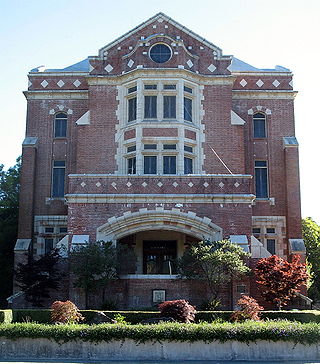
The Sonoma Developmental Center (SDC) was a large state school in California, United States for people with developmental disabilities, and is located in Eldridge in Sonoma County. Former names for this hospital include California Home for the Care and Training of Feeble Minded Children (1883); Sonoma State Home (1909); Sonoma State Hospital (1953); and Sonoma Developmental Center starting in 1986. The center closed on 31 December 2018.
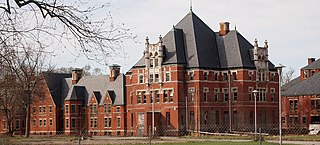
The Norwich State Hospital, originally established as the Norwich State Hospital for the Insane, later shortened to the Norwich Hospital, was a psychiatric hospital located in Preston and Norwich, Connecticut. It opened its doors in October 1904 and operated until October 10, 1996. Throughout the near century it operated, it housed geriatric patients, chemically dependent patients, and from 1931-1939, tubercular patients. The hospital, which sits on the banks of the Thames River, began with a single building on 100 acres of land, and expanded to over 30 buildings and 900 acres at its peak. A 70 acre property including the hospital was listed as a historic district on the National Register of Historic Places in 1988.
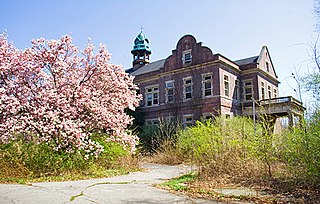
Pennhurst State School and Hospital, originally known as the Eastern Pennsylvania State Institution for the Feeble-Minded and Epileptic was a state-run institution for mentally and physically disabled individuals of Southeastern Pennsylvania located in Spring City. After 79 years of controversy, it closed on December 9, 1987.

The Rosewood Center was an institution for people with developmental disabilities located on Rosewood Lane in Owings Mills, Maryland.

The Brattleboro Retreat is a private not-for-profit mental health hospital that provides comprehensive inpatient, partial hospitalization, and outpatient treatment services for children, adolescents, and adults.

The Naval Medical Center Portsmouth (NMCP), formerly Naval Hospital Portsmouth, and originally Norfolk Naval Hospital, is a United States Navy medical center in Portsmouth, Virginia, United States. It is the oldest continuously running hospital in the Navy medical system.

The Fairview Training Center was a state-run facility for people with developmental disabilities in Salem, Oregon, United States. Fairview was established in 1907 as the State Institution for the Feeble-Minded. The hospital opened on December 1, 1908, with 39 patients transferred from the Oregon State Hospital for the Insane. Before its closure in 2000, Fairview was administered by the Oregon Department of Human Services (DHS). DHS continued to operate the Eastern Oregon State Hospital in Pendleton until October 31, 2009.
The Jacksonville Developmental Center was an institution for developmentally delayed clients, located in Jacksonville, Illinois. It was open from 1851 to November 2012. As of December 2012, the 134-acre (54 ha) grounds was still owned by the State of Illinois.

The Seaside is a historic medical facility at 36 Shore Road in Waterford, Connecticut. It is nationally significant as the first institution designed for heliotropic treatment of children suffering from tuberculosis. Its buildings "comprise an exceptional collection of fully realized and generally well-preserved Tudor Revival-style institutional architecture", which were designed by Cass Gilbert. The property was listed on the National Register of Historic Places in 1995.

Central State Hospital, originally known as the Central Lunatic Asylum, is a psychiatric hospital in Petersburg, Virginia, United States. It was the first institution in the country for "colored persons of unsound mind".
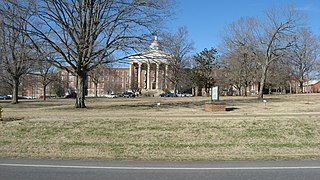
The Western State Hospital is a publicly funded psychiatric hospital in Hopkinsville, Kentucky.
Bergin Correctional Institution was a low-security state prison for men in Storrs, Connecticut. It was built in 1988 as the Northeast Correctional Institution and received its first inmates on March 13, 1989. After briefly closing in 1997 and reopening in 1999, the prison closed for good on August 12, 2011, due to years of declining prisoner population.

George Gotthilf Eitel was an American surgeon who designed and built Eitel Hospital in Minneapolis, Minnesota, in 1912. Eitel was its chief of staff for fifteen years until 1927, after which he was called proprietor.



















